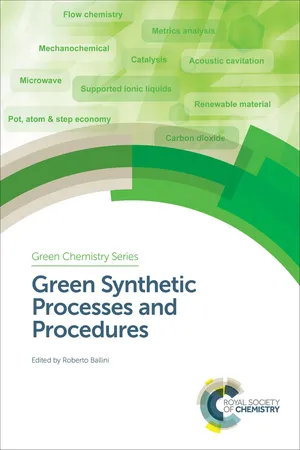
- 413 pages
- English
- ePUB (mobile friendly)
- Available on iOS & Android
Green Synthetic Processes and Procedures
About this book
The principles of Green Chemistry aim to improve the sustainability of chemical processes and reduce the generation of hazardous substances. There has been great growth in the field over the past few years and the number of research groups working in this area is still increasing. Now one of the biggest challenges is to embed the Green Chemistry ideals of safety and sustainability as standard, both in industry and academia. In order to do this, it is important to create resources that detail different applications and approaches.
Green Synthetic Processes and Procedures brings together expert contributors from across a number of areas of green synthesis to cover a diverse array of subjects. Providing a thorough overview of the current green synthetic toolbox, from biocatalysis to sonochemistry, this book is a useful resource for any chemist wishing to design cleaner and safer processes.
Frequently asked questions
- Essential is ideal for learners and professionals who enjoy exploring a wide range of subjects. Access the Essential Library with 800,000+ trusted titles and best-sellers across business, personal growth, and the humanities. Includes unlimited reading time and Standard Read Aloud voice.
- Complete: Perfect for advanced learners and researchers needing full, unrestricted access. Unlock 1.4M+ books across hundreds of subjects, including academic and specialized titles. The Complete Plan also includes advanced features like Premium Read Aloud and Research Assistant.
Please note we cannot support devices running on iOS 13 and Android 7 or earlier. Learn more about using the app.
Information
*E-mail: [email protected]
Although the ecological footprint was perhaps the first green metric, the atom economy and E-factor have become the key metrics of green chemistry by providing the mass balance of chemical reactions and processes at the molecular level. Sustainability was poorly defined originally, since the key requisite to accurately forecast the needs of future generations remains difficult to pinpoint. Consequently, sustainability was replaced with suitability by many stake holders, as they had vested and/or conflicts of interests to label suitable developments sustainable. The sustainable development goals recently introduced by the United Nations seem to serve as a ‘roadmap to happiness’ instead of metrics. A simple and independent definition of sustainability was recently provided: Nature's resources, including energy, should be used at a rate at which they can be replaced naturally, and the generation of wastes cannot be faster than the rate of their remediation by Nature. The ethanol equivalent, the sustainability values of resource replacement and fate of waste, and the sustainability indicator have been recently defined to measure the sustainability of biomass-based carbon-chemicals and renewable energy. The production of ethylene, propylene, toluene, xylenes, styrene, and ethylene oxides cannot be sustainable due to the limited amount of bioethanol. The required volume of corn and the corresponding size of land are only enough to replace one sixth of fossil resources in the USA, EU, and China, and practically insufficient in Canada and the Russian Federation. Until the utilization of electricity becomes practical and economical in aviation, biomass-based liquid fuels are the sustainable alternative.
1.1 Development and Definition of Green Chemistry
Box 1.1 The twelve principles of green chemistry 12
- It is better to prevent waste than to treat or clean up waste after it is formed.
- Synthetic methods should be designed to maximize the incorporation of all materials used in the process into the final product.
- Wherever practicable, synthetic methodologies should be designed to use and generate substances that process little or no toxicity to human health and the environment.
- Chemical products should be designed to preserve efficacy of function while reducing toxicity.
- The use of auxiliary substances (e.g., solvents, separation agents, etc.) should be made unnecessary wherever possible and, innocuous when used.
- Energy requirements should be recognized for their environmental and economic impacts and should be minimized. Synthetic methods should be conducted at ambient temperature and pressure.
- A raw material of feedstock should be renewable rather than depleting wherever technically and economically practicable.
- Unnecessary derivatization (blocking group, protection and deprotection, temporary modification of physical/chemical processes) should be avoided whenever possible.
- Catalysts (as selective as possible) are superior to reagents.
- Chemical products should be designed so that, at the end of their function, they d...
Table of contents
- Cover
- halftitle
- Series Editor
- Title
- Copyright
- Preface
- Contents
- Chapter 1 Sustainability of Green Synthetic Processes and Procedures 1
- Chapter 2 One-pot Organic Reactions 20
- Chapter 3 Application of Step, Cumulative, and Global E-factor and Process Mass Intensity Metrics to Gauge Synthesis Efficiency: l-DOPA and Apixaban Pharmaceutical Examples 39
- Chapter 4 Flow Chemistry in Drug Discovery 53
- Chapter 5 Sustainable Batch or Continuous-flow Preparation of Biomass-derived Fuels Using Sulfonated Organic Polymers 79
- Chapter 6 Renewable Starting Materials, Biocatalysis, and Multicomponent Reactions: A Powerful Trio for the Green Synthesis of Highly Valued Chemicals 115
- Chapter 7 Green Synthetic Procedures under Hydrodynamic and Acoustic Cavitation 141
- Chapter 8 Mechanochemical Synthesis of Biologically Relevant Heterocycles 175
- Chapter 9 New and Up-and-coming Perspectives for Unconventional Chemistry: From Molecular Synthesis to Hybrid Materials by Mechanochemistry 192
- Chapter 10 Microwave Dielectric Heating for Solvent-free Organic Transformations 216
- Chapter 11 Advances in Catalysis for More Sustainable Synthesis of Phenolics 245
- Chapter 12 Transition Metal Catalysis in Micellar Media: Much More Than a Simple Green Chemistry Promise 268
- Chapter 13 Supported ILs and Materials Based on ILs for the Development of Green Synthetic Processes and Procedures 289
- Chapter 14 CO2 and Organic Carbonates for the Sustainable Valorization of Renewable Compounds 319
- Chapter 15 Transition Metal-catalysed Nucleophilic Additions of Terminal Alkynes in Water: Development and Synthetic Utility 343
- Subject Index